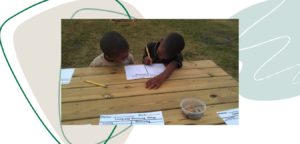Of Rural Meadows and Loblolly Pines

To view the photo-rich magazine version, click here.
Originally appears in the Winter 2022 issue.
By Arlene Marturano
When the administration of a rural school district received funding to introduce outdoor classrooms to enhance learning for Pre-K–2 students at their early childhood center (ECC), they contacted me to develop outdoor spaces for garden-based learning and to train 15 teachers to utilize the living laboratory as content for instruction to 230 youngsters aged 4–8. Early childhood is a period of rapid physical, conceptual, and social growth characterized by keen curiosity about the world around them, eager energy for sensorimotor exploration, [1] and a sense of freedom to exercise independence. [2]Since humans have an inborn tendency to affiliate with other life forms, [3]outdoor learning is critical to childhood development. The opportunities and challenges of bringing outdoor learning to rural children are presented in this article.
Forty percent of schools in South Carolina are in rural areas. [4]Its rural landscape is one of contrasts, cultural and natural. Remnants of 19th-century plantation life are hidden behind pecan groves and kudzu vines. Weathered Longleaf Pine-board cabins and sheds with tin roofs covered in cascades of green overgrowth reveal a pervasive feature of rural life — poverty. The countryside is a blend of woodlands, cotton fields, wetlands, roadside wildflowers, and amber waves of Broomsedge Grass. A nearby National Wildlife Refuge of bottomland hardwood and pine forests is an inland overwintering area for migratory ducks and geese as well as a nesting and stopover point for migratory songbirds, raptors, marsh birds, and wetland wildlife. Yet, most rural students are unaware of the avian tourists in their backyard.
The rural landscape is resplendent with natural phenomena for outdoor learning experiences. This untapped treasure trove of free teaching supplies connecting to all subject areas makes the rural location ideal for outdoor education. One of my tasks was to increase teacher awareness of, access to, and use of natural teaching tools.
This content is restricted to subscribers only.
If you are not yet a subscriber, please consider taking out a subscription here.
If you are an existing subscriber, kindly log in or contact us at info@greenteacher.com for more information.





